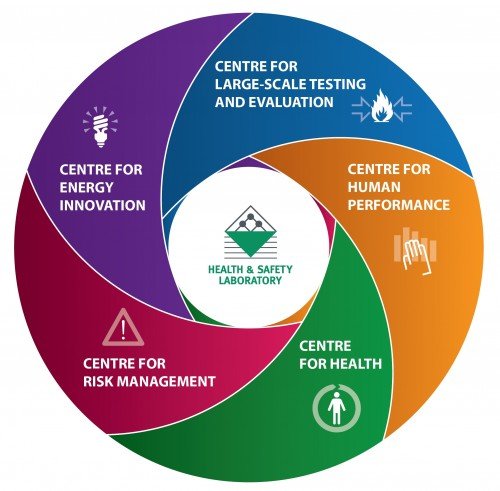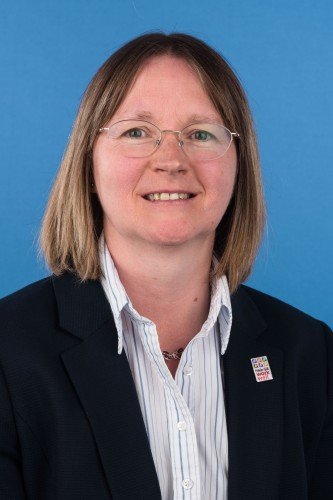 HSE’s Health and Safety Laboratory (HSL) has set up five centres to work closely with industry. In the first in a series of articles on the centres’ work, Nick Warburton talks to Karen Russ, HSE’s Science and Commercial Director, who explains how the centres link to HSE’s Helping Great Britain Work Well strategy and support the regulator’s wider goals.
HSE’s Health and Safety Laboratory (HSL) has set up five centres to work closely with industry. In the first in a series of articles on the centres’ work, Nick Warburton talks to Karen Russ, HSE’s Science and Commercial Director, who explains how the centres link to HSE’s Helping Great Britain Work Well strategy and support the regulator’s wider goals.
Earlier this year, HSE launched its new strategy Helping Great Britain Work Well, which aims to build on the nation’s impressive health and safety record by managing risk in a proportionate and effective way and by supporting innovation and increasing productivity. The strategy comprises six key themes – acting together; tackling ill health; managing risk well; supporting small employers; keeping pace with change; and celebrating success.
Committed to maintaining the high standard of science and evidence that underpins all of HSE’s regulatory work, HSL has developed five centres to work with industry to support the strategy – the Centre for Large-Scale Testing and Evaluation; the Centre for Health; the Centre for Human Performance; the Centre for Risk Management; and the Centre for Energy Innovation.
The idea is that the centres will work closely with employers, employees and stakeholders to develop a broad health and safety system for the UK. HSL has been working with many of these organisations on a commercial basis for a number of years and therefore the centres are a natural evolution in this relationship. The main difference is that whereas in the past HSL has focused primarily on individual customers, the emphasis is now on both individual customers and developing a broad industry view across sectors.
“We want to provide a mechanism for sectors to identify common health and safety issues, especially those that align with Helping Great Britain Work Well. Our first area of focus was the energy sector,” explains Karen Russ, HSE’s Science and Commercial Director, who oversees the centres.
“Our work with this sector has led us to identify a number of complex health and safety issues, which will be very important in the future in terms of where the energy sector is heading. They are far too large and broad for any one duty holder to take forward.”
HSL’s role in mapping this approach across the entire sector is critical. It will identify common issues for the future and then set up collaborative work with key players in the sector who can work with the HSL and other interested parties to resolve common problems.
“This is also where we started to establish our shared research approach to enable sector-wide issues to be addressed. Our centres are one mechanism to provide that access to the research that HSE will be looking to undertake,” continues Russ.
“We can broaden the scope and this provides an opportunity for a sector-based approach to health and safety issues where those in the sector that join us in the research can benefit from it. They will be early adopters and this will give them competitive advantage.”
As HSL developed its relationships in the energy sector over the years, it also developed a way of working, which it found could be applied across other sectors.
“We realised that other areas of expertise at HSL and industry sectors would benefit from a similar approach,” says Russ. “One that is closely aligned to the energy sector is the centre we’ve established for large-scale testing and evaluation.”
This covers the large, energetic experiments that HSL often undertakes on-site. Much of the work involves standard fire or impact testing, and bespoke testing should an organisation require assistance with a particular problem, or want to test an early concept.

Karen Russ
“We’ve been developing our expertise so that we are able to really understand the risks that will be associated with new ways of working, new processes, new equipment and new systems,” explains Russ.
“A key element is that we have a burn hall facility; a large building where we can do fire experiments. We have got new equipment set up and have been working very closely with the aerospace sector and its supply chain to come up with very hi-tech testing for new materials and components. We will broaden our knowledge and expertise even further and see the new centre as a way to do this.”
The remit for HSL’s new Centre for Health is to help organisations identify and manage health risks. Historically, the system has been focused largely on safety and the risk management of safety. The HSL has a wealth of health expertise to explore this new avenue.
“We can take everything that we’ve learnt from managing safety well to managing health,” explains Russ. “At the fundamental level, the concept of risk identification and management are very much the same. We’ve been working with organisations and used approaches that we know work so it’s now a case of applying them to health. We’ve also built on our expertise in areas such as health exposures, toxicology and microbiology.”
The centre works closely with HSL’s Risk Management Centre to ensure that the philosophy reflects a proportionate risk assessment and management approach. In a nutshell, it’s about making sure that any actions are appropriate and proportionate to mitigate the risks. The Centre for Health also works closely with the latest centre to evolve – the Centre for Human Performance.
“When you look at the risk that you have in an organisation, quite often you will find that many are associated with the interface between people, their environment, the processes, the equipment and working with other people and organisations,” she says.
“We’ve been able to target really key elements of leadership behaviours and culture. We’ve found that if you have a very strong and effective health and safety system and culture, this will lead to a broader, stronger and more effective organisational system and culture.”
While HSL is not planning a specific launch for the five centres, there are plans to host a series of events at its Buxton facility so that the organisations can meet with the experts undertaking the work and network with sector partners to help tease out current and future issues.
“Where it is a shared research agenda, we will be looking to work with some organisations in partnership,” says Russ.
“For others, we know it’s very clearly a customer/contractual relationship. However, they will still be interested in meeting other organisations so that they can access that good practice and share information. We can also talk about the longer-term future and include those interested parties that want to help us develop and identify future issues.”
To find out more about the new centres, email: [email protected]
What makes us susceptible to burnout?
In this episode of the Safety & Health Podcast, ‘Burnout, stress and being human’, Heather Beach is joined by Stacy Thomson to discuss burnout, perfectionism and how to deal with burnout as an individual, as management and as an organisation.
We provide an insight on how to tackle burnout and why mental health is such a taboo subject, particularly in the workplace.



